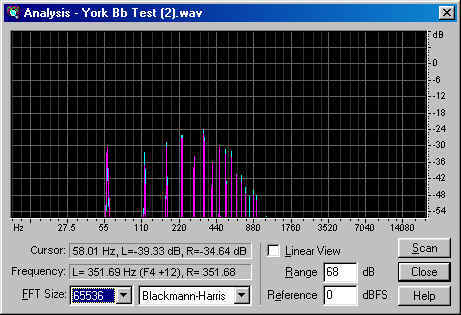
Posted by Rick Denney on April 15, 2003 at 09:23:24:
In Reply to: Re: Re: Re: Re: Re: How to stuff a PT-6 posted by Mark F. on April 14, 2003 at 21:28:37:

Show me the data.
My unlacquered Miraphone sounded better than when it was lacquered. But the reason the lacquer was removed was because I had it econo-overhauled and one reason for the "econo" was not having it lacquered. Also, I didn't want to buff and file the crap out of it to make it smooth enough so that lacquer wouldn't expose every fault.
My little Yamaha is lacquered with that heavy, thick, gooey Epoxy stuff. I've compared it with silver Yamahas, and it is among the better instruments. I've played silver 621's that I liked as well, and some that I didn't. No correlation that I can detect.
But if lacquer affects the sound, it is because it damps certain frequencies. If it damps certain frequencies, its effects will be visible in the spectrum. I'm trying to imagine what frequencies that are present in the tuba sound that could be damped by a layer of clear finish (not paint--paint has heavy pigment in it). The image above shows the frequency response of my Miraphone. The highest harmonic content that is audible is around 900 Hz. Some tubas vibrate at lower frequencies when you play, which surely affects the way the player perceives them, but those lower frequencies are well outside the damping capability of that thin finish. Any frequencies that could hope to be damped by a thin coating of lacquer are well above that frequency, in the range of sibilance.
Monsterweights affect the response of the instrument, and can have some effect on the sound, particularly how the sound is articulated. They don't damp vibration but they change the natural resonance of the instrument which changes its impedance. A belt around the bell does several things, but mostly what it does is apply compressive hoop stress on the bell stack, which preloads the material so that vibrations have to be much greater to set it to ringing, at which time, the leather itself will damp the ringing. My point is that I can think of the mechanism that makes a change in the sound. I can't think of a mechanism in the case of lacquer for frequencies of musical value on tubas.
I'm not doubting your experiences, but those experiences have many possible explanations that have nothing to do with actual physical differences in the horn. If you are going to prescribe something, it seems to me you have to go beyond experiences and explain the reasons.
As to whether Sean's answer was educated or not, I think you are confusing agreement with education.
Rick "who sees neither correlation nor causality and remains unpersuaded" Denney